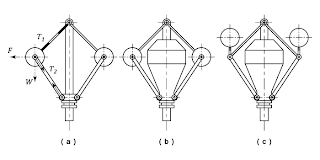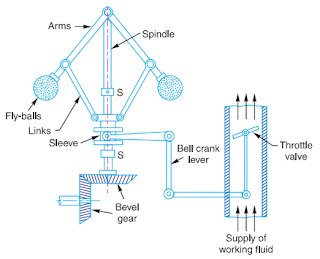1.
What is flywheel?
A flywheel
is a heavy body rotating about its axis. It acts as a reservoir of energy which
is stored in the form of kinetic energy. The extra energy is stored during the
idle stroke of the driven machinery and released during the working stroke. Thus
flywheel controls the fluctuations of speed during each cycle of the driven
machinery.
2.
What are the functions of flywheel in a
machine?
The
primary function of a flywheel is:
a.
To absorb
energy when demand of energy id less than the supply
b.
To give
out energy when demand of energy is more than the supply.
3.
What types of stresses are set up in the
flywheel rims?
a.
Tensile
stress due to the centrifugal force
b.
Tensile
bending stress due to restraint of the arms
c.
Shrinkage
stresses due to the unequal rate of cooling of casting.
4.
What are the various types of flywheel?
a.
Solid disc
type
b.
Rimmed
type with either arms or solid web
Solid disc type flywheel is rarely used
because they have less capacity of storing energy.
Rimmed type flywheels with arms are preferred
because they can store more energy. Small rimmed type flywheels are
manufactured with solid web or holes drilled in the web.
5.
Why flywheels are used in punching machines?
Use
of flywheel in punching machine is due to the following reasons:
a.
It decreases
the variation of speed during each cycle of punching machine.
b.
It decreases
the fluctuation of speed due to difference in output and input
c.
It stores
energy during idle stroke and releases during working stroke.
6.
Why flywheel is used in IC engines?
In
IC engine or stem engine the energy is developed during the power stroke, no energy
is developed during suction, compression and exhaust strokes in 4 stroke
engine. It helps the crank shaft to run at uniform speed by performing its
primary function
7.
What is the difference in the function of governor
and a flywheel?
Governor
regulates the mean speed of an engine when there are variations in load by
changing the supply of working fluid. Flywheel does not maintain a constant
speed. It reduces the fluctuations.
8.
Coefficient of fluctuation of speed is
------------ of maximum fluctuation of speed and the mean speed
Ratio
9.
Due to centrifugal forces acting on the rim,
the flywheel arms will be subjected to ------------- stresses
Tensile
10. Why
flywheel arm are usually elliptical?
This
shape helps in more section modulus for the dame weight. This results in more
strength than circular section
11. Under
what consideration the shaft for a flywheel is designed?
It
is designed under shear stresses produced due to the combined action of torsion
and bending moment.
12. In a flywheel, the major axis of the
elliptical section of the arm is the plane of rotation. Write done the reason
for this arrangement.
The
arms may have to carry the full torque load due to high inertia of the flywheel
when the energy input to its shaft is cut off. The arm may be assumed as a cantilever
fixed at the hub and carrying the load at the rim end. This bending moment lies
in the plane of rotation of the flywheel. Therefore, the major axis of the arms
must be parallel to the tangential force F acting on the flywheel.
Bending
moment on the arm, M = F(R-dh/2)
F
= t/(nR)
Where
n = number of arms
Section
modulus of arm, Z = (π/32 )b1a12
Bending
stress σb = M/Z
13. On what basis the material of flywheel is selected?
a. High
tensile strength
b. High fatigue strength
c. Low shrinkage
14. What
are the advantages of having elliptical section of flywheel arm?
The
flywheel arms are made of elliptical with major axis twice the minor axis. The major
axis lies in the plane of rotation and provides double the resistance against
bending moment.
15. Difference between flywheel and governor
The function of a governor in engine is
entirely different from that of a flywheel. It regulates the mean speed of an
engine when there are variations in the load, e.g. when the load on the engine increases, it becomes necessary
to increase the supply of working fluid. On the other hand, when the load
decreases, less working fluid is required. The governor automatically controls
the supply of working fluid to the engine with the varying load condition and
keeps the mean speed within certain limits.
As discussed above, the flywheel does not
maintain a constant speed; it simply reduces the fluctuation of speed. In other
words, a flywheel controls the speed variations caused by the fluctuation of
the engine turning moment during each cycle of operation. It does not control
the speed variations caused by the varying load.
16. Define the
following terms
Coefficient of Fluctuation of Speed, coefficient of
steadiness, fluctuation of energy, maximum fluctuation of energy, Coefficient
of Fluctuation of Energy
Coefficient of
fluctuation of speed: The difference between the maximum and
minimum speeds during a cycle is called the maximum fluctuation of speed. The ratio of the maximum
fluctuation of speed to the mean speed is called coefficient of fluctuation of speed.
Coefficient of steadiness: The reciprocal of coefficient of fluctuation of speed is
known as coefficient of steadiness and it is denoted by m.
Fluctuation
of energy, maximum fluctuation of energy:
The
fluctuation of energy may be determined by the turning moment diagram for one
complete cycle of operation. Consider a turning moment diagram for a single
cylinder double acting steam engine as shown in Fig. The vertical ordinate represents the turning
moment and the horizontal ordinate (abscissa) represents the crank angle.

A
little consideration will show that the turning moment is zero when the
crank
angle is zero. It rises to a maximum value when crank angle reaches 90º
and it is
again zero when crank angle is 180º. This is shown by the curve abc in
Fig. and it represents the
turning moment diagram for outstroke. The curve cde is the turning
moment diagram for instroke and is somewhat
similar to the curve abc. Since
the work done is the product of the turning moment and the angle turned,
therefore the area of the turning moment diagram represents the work
done per
revolution. In actual practice, the engine is assumed to work against
the mean
resisting torque, as shown by a horizontal line AF. The height of the
ordinate aA represents the mean height of the turning moment diagram.
Since it is assumed that the work done by the turning moment per
revolution is
equal to the work done against the mean resisting torque, therefore the
area of
the rectangle aA Fe is
proportional to the work done against the mean resisting torque. We see
in Fig.
that the mean resisting torque line AF cuts the turning moment diagram
at
points B, C, D and E. When
the crank moves from ‘a’ to ‘p’ the work done by the engine is
equal to the area aBp, whereas
the energy required is represented by the area aABp. In other words, the
engine has done less work (equal to
the area aAB) than the
requirement. This amount of energy is taken fromthe flywheel and hence
the
speed of the flywheel decreases. Now the crank moves from p to q, the
work done by the engine is equal to the area pBbCq, whereas the
requirement of
energy is represented by the area pBCq.
Therefore the engine has done more work than the requirement. This
excess work (equal
to the area BbC) is stored in
the flywheel and hence the speed of the flywheel increases while the
crank
moves from p to q.
Similarly
when
the crank moves from q to r, more work is taken from the engine
than is developed. This loss of work is represented by the area CcD. To
supply this loss, the
flywheel gives up some of its energy and thus the speed decreases while
the
crank moves from q to r. As the crank moves from r to s, excess energy
is again developed given by the area DdE and the speed again increases.
As
the piston moves from s to e, again there is a loss of work and
the speed decreases. The variations of energy above and below the mean
resisting torque line are called fluctuation
of energy. The areas BbC,
CcD, DdE etc. represent fluctuations of energy. A little
consideration will show that the engine has a maximum speed either at q
or at s. This is due to the fact that the flywheel absorbs energy
while the crank moves from p to
q and from r to s. On the other hand, the engine has a minimum speed
either at p or at r. The reason is that the flywheel gives out some of
its energy when
the crank moves from a to p and from q to r. The difference
between the maximum and the minimum energies is known as maximum fluctuation of energy
Coefficient of Fluctuation of Energy
It is defined as the ratio of the maximum
fluctuation of energy to the work done per cycle. It is usually denoted by CE





